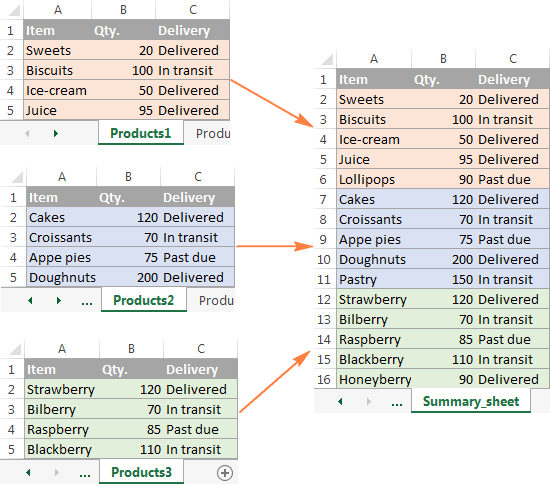Combine All Excel Sheets into One Easily

Why Combining Excel Sheets is Essential

In today's business environment, data integration plays a critical role in decision-making and process optimization. Excel, as the most widely used spreadsheet software, facilitates this by allowing you to combine multiple sheets into one comprehensive document. Whether you're working with sales data, inventory, or financial reports, combining Excel sheets can provide a holistic view of your data, streamline reporting, and facilitate better analysis. Here’s why merging Excel sheets is essential:
- Efficiency - Saves time and reduces manual effort when consolidating data from various sources.
- Data Integrity - Ensures data from all sources are consistent and can be compared side by side.
- Improved Analysis - Easier to perform in-depth analysis when all relevant data is housed in one place.
- Better Decision Making - With all the data at your fingertips, decisions can be made more quickly and accurately.
Manual Methods for Combining Excel Sheets

There are several manual ways to combine Excel sheets, suitable for smaller datasets or when you need to keep a process simple:
Copy and Paste

The most straightforward method for combining sheets is through copy and pasting. Here’s how you do it:
- Open the workbook containing the sheets you want to merge.
- Select all the data from the first sheet.
- Copy the data (Ctrl + C or right-click and select ‘Copy’).
- Switch to the destination sheet or workbook.
- Place the cursor where you want the data to be inserted.
- Paste the data (Ctrl + V or right-click and select ‘Paste’).
- Repeat for additional sheets if necessary.
📌 Note: This method can be time-consuming and error-prone for large datasets.
Using the Consolidate Feature

Excel’s consolidate feature can handle data from multiple sheets and provides more options for merging:
- Select the destination cell where you want to consolidate the data.
- Navigate to the Data tab, and choose ‘Consolidate’.
- In the Function box, select the appropriate function to use for consolidation (e.g., ‘Sum’, ‘Average’).
- In the ‘Reference’ box, type or select the range from one of the sheets to consolidate.
- Click ‘Add’ and repeat for other sheets.
- Set any necessary options like ‘Top row’ or ‘Left column’ labels if your data uses headers.
- Click ‘OK’ to finish.
This method is versatile and can handle functions like summing or averaging data from different sheets.
📌 Note: Ensure all source sheets have consistent column headers for a seamless consolidation process.
Using Excel Power Query to Merge Sheets

For larger datasets or more complex merges, Power Query provides an automated and powerful solution:
- In Excel, navigate to the Data tab and click on 'Get Data'.
- Select 'From File' and then 'From Workbook' to import your Excel file.
- Navigate to the appropriate workbook and select it.
- Power Query will load the workbook and display all available tables.
- Select the tables you want to combine, right-click, and choose 'Append Queries'.
- Select the kind of merge you want: 'Append Queries as New', 'Append Queries', or 'Merge Queries'.
- Follow the wizard to merge the data as required.
- Load the merged data back into Excel.
Power Query offers advanced functionalities like renaming columns, filtering data before merging, and handling mismatched headers effectively.
Using VBA to Automate Sheet Merging

If you're familiar with VBA (Visual Basic for Applications), you can automate the process of combining sheets:
Sub MergeExcelFiles() Dim FolderPath As String, FilePath As String, FileName As String Dim WB As Workbook, WS As Worksheet, DestWS As Worksheet Dim LastRow As Long, DestLastRow As Long Dim SourceRange As Range, DestRange As Range' Set the path for the folder containing the files FolderPath = "C:\YourFolderPath\" FileName = Dir(FolderPath & "*.xlsx") Application.ScreenUpdating = False Application.DisplayAlerts = False Set DestWB = ThisWorkbook Set DestWS = DestWB.Sheets.Add DestWS.Name = "Combined Data" Do While FileName <> "" FilePath = FolderPath & FileName Set WB = Workbooks.Open(FilePath) For Each WS In WB.Sheets With WS LastRow = .Cells(.Rows.Count, "A").End(xlUp).Row If LastRow > 1 Then Set SourceRange = .Range("A1:I" & LastRow) Set DestWS = DestWB.Sheets("Combined Data") DestLastRow = DestWS.Cells(DestWS.Rows.Count, "A").End(xlUp).Row Set DestRange = DestWS.Range("A" & DestLastRow + 1 & ":I" & DestLastRow + SourceRange.Rows.Count) SourceRange.Copy DestRange End If End With Next WS WB.Close SaveChanges:=False FileName = Dir Loop Application.ScreenUpdating = True Application.DisplayAlerts = True
End Sub
This VBA code will automatically scan a designated folder for Excel files, open each file, and merge data from every sheet into a new “Combined Data” sheet in the active workbook.
⚠️ Note: Backup your data before running any VBA script to prevent accidental data loss.
In summary, merging Excel sheets can be done manually through copy-pasting or using features like Consolidate, or automated with tools like Power Query or VBA. Each method has its advantages:
- Manual Methods: Best for small datasets or when you want to keep things simple and avoid complexity.
- Power Query: Ideal for large datasets with complex merging requirements, offering data transformation and filtering capabilities.
- VBA: Useful for frequent or repetitive tasks where automation can save significant time.
The choice depends on the volume of data, complexity of the merge, and the user’s comfort with Excel’s features. Combining Excel sheets ensures that you have a unified view of your data, making analysis, reporting, and decision-making processes more efficient and accurate.
How often should I merge my Excel sheets?

+
The frequency depends on your data update cycle and analysis needs. For daily reports, you might merge sheets daily, while monthly reports might require a monthly merge.
Can I undo the merging process if I make a mistake?

+
Yes, if you’ve kept the source sheets intact, you can revert by deleting the merged data. However, always backup before major operations to avoid data loss.
What if my sheets have different structures?

+
Use Power Query or VBA, which can handle inconsistencies by matching headers or manually mapping data during the merge process.



